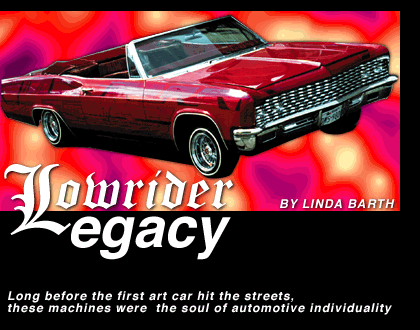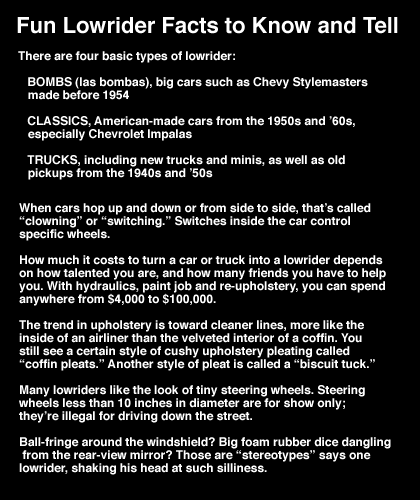 | 
 |
 |
|  When Roadside Attractions: The Artists Parade of Art Cars rolls through downtown Houston on April 19, a cadre of gleaming lowriders will be among its stars. They'll fit right in. Lowriders aren't just cars with fancy pinstriping and custom hydraulics, they're symbols of a culture with a proud history that predates the modern art car. When Roadside Attractions: The Artists Parade of Art Cars rolls through downtown Houston on April 19, a cadre of gleaming lowriders will be among its stars. They'll fit right in. Lowriders aren't just cars with fancy pinstriping and custom hydraulics, they're symbols of a culture with a proud history that predates the modern art car. |
 |
|  The term "lowrider" can apply to a car, truck, bicycle or motorcycle that has been lowered to within a few inches of the ground; it can also describe a person who owns or helps create one of these vehicles. Once solely the pride of the barrios, lowriders have captured the world's fancy. "You see Japanese lowriders dressing like Mexicans with the Mexican flag," says Shorty Villarreal of Shorty's Hydraulics in the Houston Heights. Villarreal says his ad in Lowrider magazine (which has a circulation of 239,000) brings him calls from as far away as Japan, Australia and Greenland. The term "lowrider" can apply to a car, truck, bicycle or motorcycle that has been lowered to within a few inches of the ground; it can also describe a person who owns or helps create one of these vehicles. Once solely the pride of the barrios, lowriders have captured the world's fancy. "You see Japanese lowriders dressing like Mexicans with the Mexican flag," says Shorty Villarreal of Shorty's Hydraulics in the Houston Heights. Villarreal says his ad in Lowrider magazine (which has a circulation of 239,000) brings him calls from as far away as Japan, Australia and Greenland.
|
 |
|  Lowriding is believed to have originated in Los Angeles in the 1920s when Latinos began pinstriping their cars to make them stand out in a sea of assembly-line autos. They used ingenuity instead of lots of money to give their cars class. By the 1930s, painted flames on lowrider cars were quite the rage, and some drivers adopted a zoot-suit style of dressing with felt fedora, baggy pants and a long, floppy coat called a tacuche. Car bodies were brought close to the ground by removing a horizontal section of the car or by cutting away the springs. It gave the cars a wicked look. Lowriding is believed to have originated in Los Angeles in the 1920s when Latinos began pinstriping their cars to make them stand out in a sea of assembly-line autos. They used ingenuity instead of lots of money to give their cars class. By the 1930s, painted flames on lowrider cars were quite the rage, and some drivers adopted a zoot-suit style of dressing with felt fedora, baggy pants and a long, floppy coat called a tacuche. Car bodies were brought close to the ground by removing a horizontal section of the car or by cutting away the springs. It gave the cars a wicked look.
|
 |
|  |
 |
| Back to Road Guide Home Page |



